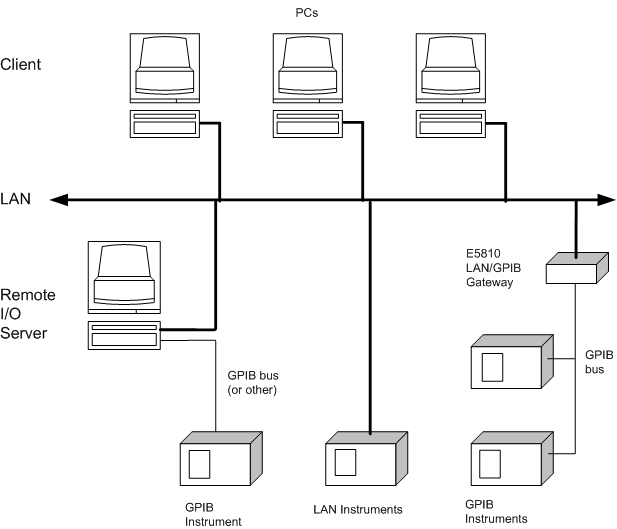LAN and Remote Interfaces Overview

 This section contains information that applies to both Windows and Linux.
This section contains information that applies to both Windows and Linux.
This topic contains an overview of LAN (Local Area Network) interfaces. A LAN is a way to extend the control of instrumentation beyond the limits of typical instrument interfaces. To communicate with instruments over the LAN, you must first configure a LAN interface or a remote GPIB, USB, or serial interface, using the Keysight Connection Expert.
Direct LAN Connection versus Remote IO Server/Client Connection
Some instruments support direct connection to the LAN. These instruments include an RJ-45 or other standard LAN connector and software support for operating as an independent device on the network. Some of these instruments are Web-enabled, meaning that they host a Web page which you can access over the LAN.
With the Keysight IO Libraries Suite, you can connect to instruments across the LAN even if they do not have direct LAN capability, if they are connected to gateways (such as the Keysight E5810) or to another PC running the Remote IO Server software.
Refer to the IO Libraries Suite Help (Open help using IO Control application)for information on connecting and configuring different types of LAN instrument connections.
Remote IO Server/Client Architecture
The Remote IO Server and Client software provided with the Keysight IO Libraries Suite allows instrumentation to be controlled over a LAN. Using standard LAN connections, instruments can be controlled from computers that do not have special interfaces for instrument control.
Client/Server Model
The IO Libraries Suite software uses the client/server model of computing. Client/server computing refers to a model in which an application (the client) does not perform all necessary tasks of the application itself. Instead, the client makes requests of another computing device (the remote I/O server) for certain services.
As shown in the following figure, a remote I/O client (a Windows PC) makes VISA requests over the network to a remote I/O server (such as a Windows PC, an E5810 LAN/GPIB Gateway, or a Series 700 HP-UX workstation).
Gateway Operation
The remote I/O server is connected to the instrumentation or devices to be controlled. Once the remote I/O server has completed the requested operation on the instrument or device, the remote I/O server sends a reply to the client. This reply contains the requested data and status information that indicates whether or not the operation was successful. The remote I/O server acts as a gateway between the LAN software that the client system supports and the instrument-specific interface that the device supports.
|
|
